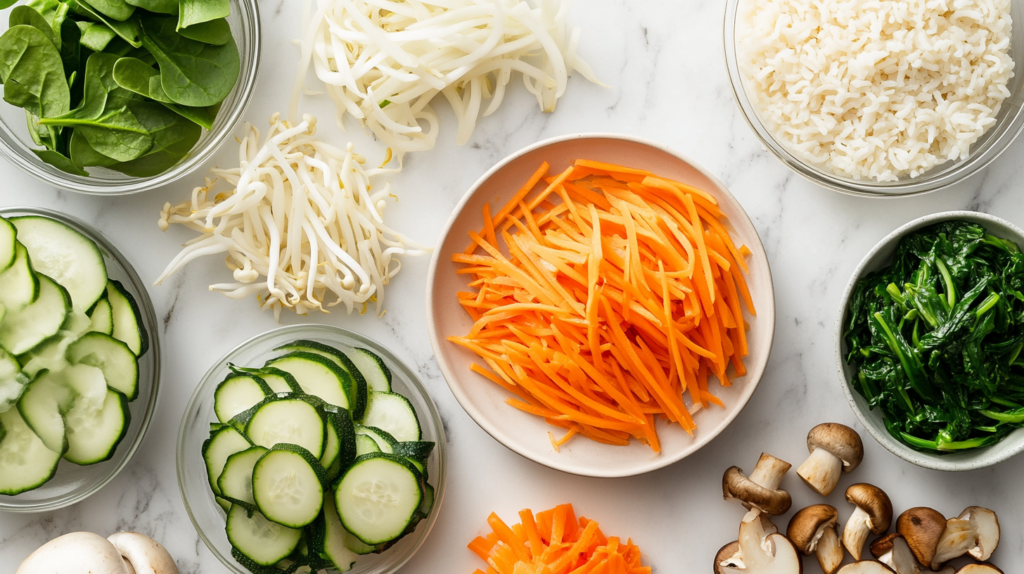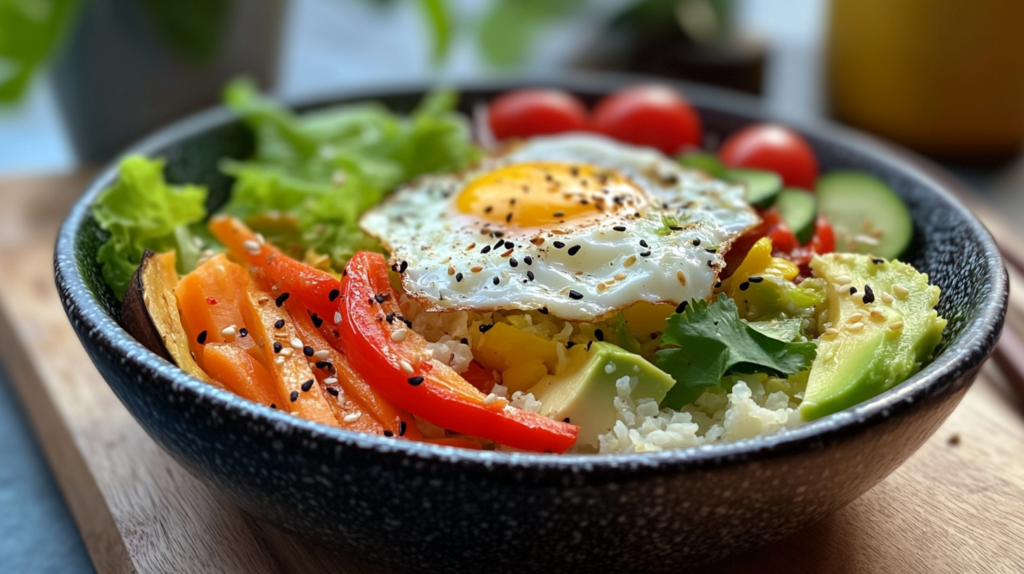Is Korean Bibimbap Healthy? Yes, bibimbap is a nutritious and well-balanced meal that provides a variety of vitamins, minerals, and macronutrients. This Korean rice bowl includes fresh vegetables, protein, and flavorful seasonings, making it a wholesome dish. However, its health benefits depend on the ingredients and preparation methods. In this article, we’ll explore the nutritional value of bibimbap, its potential health concerns, and tips to make it even healthier. Keep reading to discover if bibimbap is the right addition to your healthy diet!
Table of Contents
What Is Bibimbap?
Bibimbap (비빔밥) literally translates to “mixed rice” in Korean. It is a traditional dish that consists of a bowl of warm rice topped with an assortment of sautéed or fresh vegetables, a protein source (such as beef, chicken, tofu, or eggs), and a dollop of gochujang (Korean red chili paste). The dish is typically mixed together before eating, ensuring that every bite is full of flavor and texture.
Origin and Cultural Significance
Bibimbap has been a staple in Korean cuisine for centuries. Historically, it was a way to use up leftover vegetables and rice, making it an economical and sustainable dish. Some theories suggest that it was originally eaten by farmers or during special occasions like Jeongwol Daeboreum, a Korean holiday that celebrates the first full moon of the year. Today, bibimbap is enjoyed worldwide, both in traditional forms and modern adaptations.
Common Ingredients in Bibimbap
Bibimbap can be customized in many ways, but a standard bowl typically includes:
- Rice – Usually white rice, but brown rice or other grains can be used.
- Vegetables – Carrots, spinach, zucchini, mushrooms, bean sprouts, and radish are common choices.
- Protein – Beef (bulgogi), chicken, tofu, or a fried egg.
- Gochujang Sauce – A spicy-sweet fermented chili paste mixed with sesame oil, garlic, and other seasonings.
- Sesame Seeds and Oil – Used for flavor and garnish.
Since bibimbap contains a mix of carbohydrates, proteins, and fats, it provides a well-rounded meal. However, the healthiness of bibimbap depends on the ingredients and portion sizes.
Nutritional Breakdown of Bibimbap
Calories and Macronutrients
The calorie count of bibimbap can vary based on portion size and ingredients, but a standard serving (about 500 grams) contains:
- Calories: 500-600 kcal
- Carbohydrates: 65-75g
- Protein: 15-25g
- Fat: 10-15g
If made with lean protein and less oil, bibimbap can be a relatively low-calorie meal while still being filling.
Vitamins and Minerals in Bibimbap
Since bibimbap includes a variety of vegetables, it provides an excellent source of essential vitamins and minerals, such as:
- Vitamin A & C – Found in carrots, spinach, and other veggies, these vitamins support immunity and skin health.
- Iron – Present in spinach and beef, helping with oxygen transport in the body.
- Calcium – Found in sesame seeds and leafy greens, good for bone health.
- Fiber – Helps with digestion and gut health, mainly from vegetables and brown rice (if used).
Protein, Fiber, and Healthy Fats
- Protein: Whether from eggs, tofu, or meat, bibimbap is a good source of protein, which is important for muscle repair and satiety.
- Fiber: The dish is rich in fiber, thanks to the vegetables and whole grains (if brown rice is used), aiding digestion.
- Healthy Fats: Sesame oil and seeds provide unsaturated fats that support heart health.
Health Benefits of Bibimbap
Is Korean Bibimbap Healthy?
Bibimbap includes a variety of colorful vegetables, each offering antioxidants that protect against free radicals and inflammation. These nutrients help support heart health, immunity, and skin health.
A Good Source of Lean Protein
If bibimbap is made with lean meats or plant-based proteins like tofu, it can be an excellent source of protein, which helps with muscle growth and overall energy levels.
Supports Digestive Health
Since bibimbap contains fiber-rich vegetables and fermented ingredients like gochujang, it promotes healthy digestion and gut health.
Low in Processed Ingredients
Unlike many fast-food meals, bibimbap is made from whole, minimally processed ingredients, making it a healthier choice compared to many other rice-based dishes.
Potential Health Concerns of Bibimbap
While bibimbap is generally a nutritious dish, there are some potential health concerns depending on the ingredients and preparation method.
High Sodium Content in Some Variations
One of the biggest concerns with bibimbap is its sodium content. The gochujang sauce, soy sauce, and other seasonings used in bibimbap can contribute to high sodium intake, which may lead to:
- Increased blood pressure
- Water retention
- Risk of heart disease
To reduce sodium levels, you can use low-sodium soy sauce or control the amount of gochujang in your bowl.
Impact of White Rice on Blood Sugar
Most traditional bibimbap is made with white rice, which has a high glycemic index (GI). This means it can cause blood sugar spikes, which may not be ideal for:
- People with diabetes
- Those following a low-carb diet
- Anyone looking for sustained energy levels
A simple swap to brown rice, quinoa, or cauliflower rice can lower the glycemic impact and increase fiber content.
Excessive Use of Oils and Sauces
Sesame oil adds a nutty flavor and healthy fats, but using too much oil can increase the caloric density of bibimbap. Similarly, adding too much gochujang sauce can increase sugar and sodium levels.
To make a healthier bibimbap, use:
✔ Less oil for cooking vegetables
✔ A controlled portion of gochujang or use a lighter sauce like vinegar-based dressings
How to Make Bibimbap Healthier?

If you love bibimbap but want to make it even more nutritious, here are some smart modifications:
Choosing Brown Rice or Cauliflower Rice
Instead of white rice, try:
- Brown rice (for more fiber and nutrients)
- Quinoa (for added protein)
- Cauliflower rice (for a low-carb option)
This switch reduces blood sugar spikes and boosts fiber intake.
Using Lean Protein Options
For a healthier bibimbap, opt for:
✔ Tofu or tempeh for a plant-based protein source
✔ Grilled chicken or lean beef instead of fatty cuts
✔ Egg whites instead of a whole egg (to reduce cholesterol intake)
Reducing Sodium and Sugar in Sauces
Instead of high-sodium soy sauce and gochujang, try:
- Homemade gochujang with less sugar and salt
- Low-sodium soy sauce
- A mix of sesame oil, lemon juice, and garlic for a fresh alternative
By making these adjustments, you can enjoy bibimbap regularly without worrying about unhealthy additives.
Homemade Healthy Bibimbap Recipe

If you want to enjoy bibimbap in the healthiest way possible, making it at home is the best option. This simple and nutritious bibimbap recipe ensures you get all the flavors while keeping it balanced and healthy.
Ingredients (Serves 2-3)
Base:
- 2 cups cooked brown rice (or cauliflower rice for a low-carb option)
Vegetables:
- ½ cup carrots, julienned
- ½ cup zucchini, julienned
- ½ cup spinach, steamed
- ½ cup bean sprouts, blanched
- ½ cup mushrooms, sliced (shiitake or button)
- ½ cup radish, thinly sliced
Protein Options:
- 1 cup tofu, diced and pan-seared (for a vegetarian/vegan option)
- ½ cup lean chicken breast, grilled and sliced (for a high-protein option)
- 1 fried egg per serving (optional but traditional!)
Gochujang Sauce:
- 2 tbsp gochujang (Korean red chili paste – use low-sodium for a healthier option)
- 1 tbsp rice vinegar (for tanginess)
- 1 tbsp low-sodium soy sauce (for umami flavor)
- 1 tsp honey or maple syrup (for natural sweetness)
- 1 tsp sesame oil (adds depth of flavor)
- 1 clove garlic, minced
Garnish:
- 1 tbsp sesame seeds (for crunch and healthy fats)
- 1 tbsp green onions, chopped (for freshness)
Instructions
Step 1: Prepare the Rice
- Cook brown rice according to package instructions.
- If using cauliflower rice, lightly sauté it in a dry pan for 3-4 minutes to remove moisture.
Step 2: Cook the Vegetables
- Carrots & Zucchini: Sauté lightly in 1 tsp sesame oil until tender but still crunchy.
- Spinach & Bean Sprouts: Blanch in boiling water for 30 seconds, then drain.
- Mushrooms: Sauté in 1 tsp sesame oil until golden brown.
Step 3: Cook the Protein
- Tofu: Pan-fry until golden on all sides.
- Chicken: Grill or sauté with a pinch of salt and pepper until cooked through.
- Egg: Fry an egg sunny-side up for the classic bibimbap look.
Step 4: Make the Sauce
- In a small bowl, whisk together gochujang, soy sauce, vinegar, honey, sesame oil, and garlic.
Step 5: Assemble the Bibimbap
- In a large bowl, add a scoop of rice.
- Arrange the vegetables and protein in sections over the rice.
- Place the fried egg (if using) in the center.
- Drizzle the gochujang sauce over everything.
- Sprinkle with sesame seeds and green onions.
Step 6: Mix and Enjoy!
- Before eating, mix everything together so the sauce coats all ingredients. Enjoy warm!
Tips for a Healthier Bibimbap:
✔ Use less gochujang if you’re watching sodium intake.
✔ Swap white rice for quinoa or cauliflower rice for more fiber and fewer carbs.
✔ Add kimchi for extra probiotics and gut health benefits.
✔ Bake or grill protein instead of frying to cut down on extra oil.
Comparing Bibimbap to Other Korean Dishes
Bibimbap vs. Kimbap: Which Is Healthier?
| Feature | Bibimbap | Kimbap |
|---|---|---|
| Calories | Moderate (500-600 kcal) | Lower (350-450 kcal) |
| Protein | Higher (with meat/egg) | Moderate |
| Carbs | Higher (due to rice) | Moderate |
| Nutrient Density | High (lots of vegetables) | Moderate (fewer vegetables) |
Winner: Bibimbap is healthier due to higher fiber and protein content, but kimbap is a lower-calorie option.
Bibimbap vs. Japchae: Nutritional Differences
| Feature | Bibimbap | Japchae |
|---|---|---|
| Base Ingredient | Rice | Sweet potato noodles |
| Calories | Moderate | Higher (due to oil) |
| Protein | High | Moderate |
| Fiber | High | Moderate |
Winner: Bibimbap is generally healthier due to lower oil content and higher fiber.
Bibimbap vs. Kimchi Fried Rice: Which to Choose?
| Feature | Bibimbap | Kimchi Fried Rice |
|---|---|---|
| Cooking Method | Fresh ingredients | Stir-fried (more oil) |
| Calories | Moderate | High |
| Sodium | Moderate | High (due to kimchi and sauce) |
Winner: Bibimbap is the healthier choice because kimchi fried rice often contains more sodium and oil.
FAQs About Bibimbap and Health
Is Bibimbap Good for Weight Loss?
Yes! Bibimbap can be a weight-loss-friendly meal if made with: ✔ Brown rice or cauliflower rice – Opting for whole grains or low-carb alternatives like purple sweet potatoes can boost fiber intake and reduce calorie density.✔ Brown rice or cauliflower rice
✔ Lean protein (chicken, tofu, or egg whites) – These help maintain muscle while keeping calories in check.
✔ Less oil and controlled sauce portions – Too much sesame oil or gochujang sauce can add excess calories.
Can Bibimbap Be Made Vegan?
Absolutely! Just replace meat with tofu, tempeh, or mushrooms, and ensure that your sauce is vegan-friendly. For more inspiration on Korean flavors, check out this Korean recipes guide.
How Often Should You Eat Bibimbap?
Bibimbap can be eaten regularly if balanced with healthy ingredients. If made with too much rice, oil, or sauce, it’s best to eat it in moderation.
Is Bibimbap Good for People with Diabetes?
For diabetics, white rice may cause blood sugar spikes. Choosing brown rice or quinoa can make bibimbap a diabetes-friendly meal.
Conclusion: Is Korean Bibimbap Healthy?
The answer is yes—bibimbap can be a healthy and balanced meal when prepared with the right ingredients. Its high vegetable content, lean protein, and fiber-rich options make it a great choice for anyone looking for a nutritious and satisfying dish.
Key Takeaways:
✔ Bibimbap is rich in vitamins, minerals, and antioxidants.
✔ It provides a good balance of carbs, protein, and healthy fats.
✔ Choosing whole grains, lean protein, and less sauce makes it even healthier.
✔ It’s a better choice than many other Korean dishes in terms of nutrition.
Whether you’re trying to lose weight, eat healthier, or simply enjoy Korean cuisine, bibimbap is a great option—just be mindful of portion sizes and ingredient choices. If you’re interested in gluten-free eating, you might also find Is Brown Sugar Gluten-Free? useful for understanding how sugar fits into a healthy diet.

